I've always wanted to try sailing, and last winter I really
got the bug, started searching the net and stumbled upon Jim's
essays.
The photos are from the August 1 trials (maiden voyage). A few
are from various points during construction.
Before stumbling upon Michalak's stuff, I found several used
copies of the Payson classics, and strongly considered one of
Bolger's designs, and became quite familiar with his design
and use of the sprit boom.
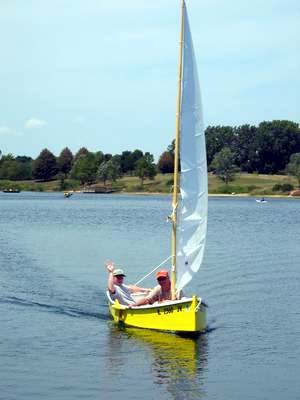
But, I ended up deciding to build the Michalak Mixer.
Not one to leave well-enough alone, I decided I liked the simple
elegance of the sprit-boom rig, and adapted the design to the
Mixer. By my calculations, the placement of the mast would be
fine with the sprit-boom provided the rake was adjusted to about
2-1/2 degrees. I made three different partners just in case,
one providing 0 degrees of rake, one providing 2 1/4 degrees
of rake, and one providing 4 1/2 degrees of rake. I started
with the 2 1/2 degree partner, and everything seemed fine, so
far, providing a touch of weather helm when on a close reach
with the sheet held directly in the hand (as opposed to running
through a tiller-mounted fairlead). But I have only sailed the
boat three times, and those outings constitute my entire experience
sailing.
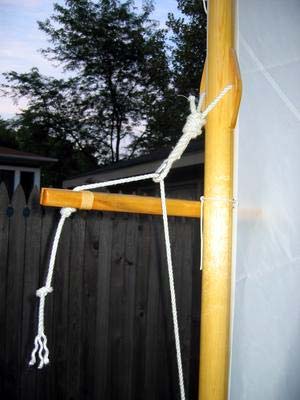
I had planned on making the sail myself, but with a new baby
in the house and time tight, I ordered one of Payson's teal
sails from Bohndell. I plan to give sail making a try, though
- I found "The Sail Maker's Apprentice" intriguing.
I'd like to try a gaff rig. Having now actually used the sprit-boom
rig as constructed with fixed mast lashings, I think I would
prefer to have a halyard.
I also increased the size of the leeboard to better fit Michalak's
present goal of 4% area (the original leeboard design seemed
a bit undersized).
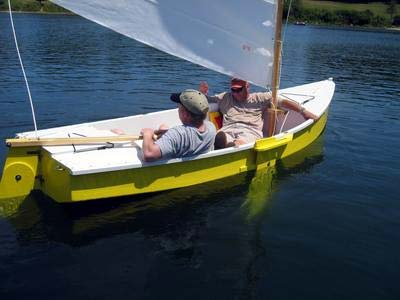
I am presently reading Leather's Gaff Rig Handbook. While the
sprit-boom rig is utter simplicity, the gaff rig offers ultimate
control. And, I am guessing, is lots of fun to handle when sailing
(with all that running rigging!).
If I do build a gaff rig, I would size proportion it normally,
but increase the overall area and add one or two rows of reef
points. Balance would naturally shift aft, resulting in lee
helm, unless a jib is added. So, a bow sprit of some sort will
need to be added.
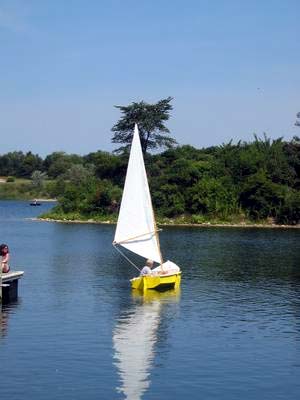
As I was building the boat, a neighbor (who I did not know
at the time) was passing by and saw the work and swung his car
into my driveway. He introduced himself as a sailor and indicated
he had never seen anyone build a sailboat before and was intrigued.
He made several periodic visits and invited himself along for
the maiden voyage. He was very skeptical of the leeboard, prefering
a centerboard. After my initial solo sail with the successful
upwind return to the dock, he and I went out with him at the
tiller - he certainly could make the Mixer go! What is particularly
interesting is his experience taking my wife out for a run -
they got to the lee side of the small lake and I could see him
tacking back and forth. I realized the lee board had kicked
up, and he was unable to go upwind. I ran around the lake to
advise him of the problem. He put the lee board down and was
able to come right in - it made him a believer in the lee board
at that point. My neighbor was extremely impressed with the
way the boat handled.

Because of our cold wet spring this year (as I was contemplating
starting the Mixer proper), I decided that oars would warm me
up. I kept my oars short to fit within the cockpit. The Mixer
plans include plans for 6 1/2' oars for just this purpose. Michalak's
book includes plans for slightly longer oars, as do his essays.
I am not an experienced oarsman. But, from what I have read,
6 1/2' is very short. My oars are only intended to get me out
of a sticky sailing situation (at least that is my present thinking
- I may try rowing for fun sometime).

Although Michalak lays them out on a 1 x 6, I had some 1 x
8 pine, resulting in more waste. I thought I would be able to
minimize the knots, but that pine was horrible! I had to waste
a few boards that warped quite unbelievably when I started ripping
the parts out.
I ended up setting the parts aside to await the anticipated
boat construction down time. Getting back to the oars, however,
ended up being one of the last things I did, and I cranked them
out from glue to finish over a period of about three days.
I glued the plies with Tightbond. Planed them by hand with
a block plane (as I did my mast and sprit). I would have liked
to have had a spoke shave.
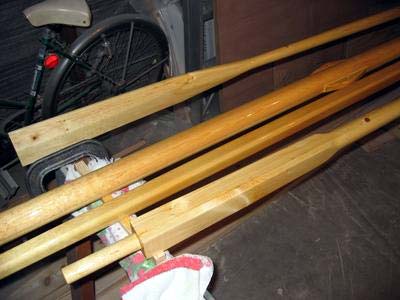
I think the pictures flatter them - in person they're a bit
rough around the edges - I hurried them since they were somewhat
holding up the launching. I was convinced I would need them
to get back to the dock
since I knew neither how to sail nor whether the design modifications
would work. Funny, however, they haven't even touched the water,
yet!
I had thought to add some PVC tubing inlet into the forward
(or aft) flotation bulkhead, mounted to a flange sealed to the
bulkhead and with a cap on the inside end, to provide pockets
for the shafts of the oars. But, so far this has not happened,
and the oars, with the exception of the maiden voyage, stay
in the car [where they will do me a lot of good when I need
them ;(
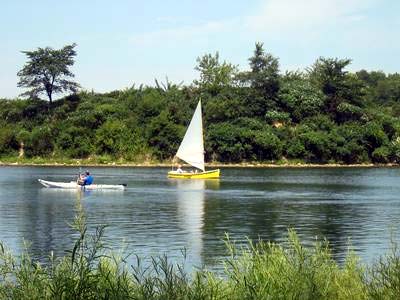
As you can tell ,I am pleased with my Mixer. But, you might
want to temper that enthusiasm with the knowledge that I am
a complete novice sailor/boater!

